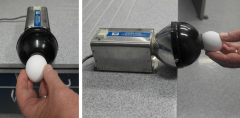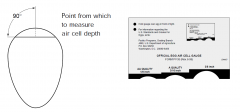Market Eggs - Interior egg grading by candling
The interior grades of eggs are set by the United States Department of Agriculture and include Grades AA, A, B, and Loss. Dirty and cracked eggs are removed as Loss eggs. The specific standards for the USDA egg grades are shown in Table 1.
Table 1. Summary of USDA Standards for interior quality of eggs by candling for 4-H poultry judging.
To evaluate the interior quality of eggs without breaking them open, the eggs are candled. Candling takes place in a darkened room and involves shining a light through the egg. To candle an egg, hold the small end of the egg between your thumb and first two fingers. Place the large end up to the candling light in a slanting position (see Figure 1). You can see the air cell and the yolk shadow within the albumen. For any 4-H poultry judging contest, the air cell will always be at the large end of the egg. While holding the egg between your thumb and first two fingers, turn your wrist back and forth (Figure 1). This will cause the contents of the egg to twirl. The movement of the contents can tell you a great deal about the yolk and albumen.

When rotating the egg held up to the light, you may see the shadow of the yolk. The yolk of a fresh, high-quality egg will be surrounded by a rather dense layer of albumen. As a result, the yolk moves only slightly away from the center of the egg when it is twirled while being candled. Because of this, the yolk outline is indistinct or partially visible. As the egg ages or deteriorates in quality, the albumen becomes thinner and the yolk tends to move more freely and approaches the shell more closely. The yolk then becomes more visible when candled. The condition of the albumen, therefore, is determined largely by the movement of the egg yolk when the egg is candled. When twirling the egg, if the yolk retains its position in the center, the white is usually firm and thick.
While observing the movement of the egg contents while twirling the egg, any blood or meat spots present will be visible. If there are small blood or meat spots that together total less an 1/8 inch in diameter, the egg is a grade B. If there are large blood or meat spots (greater than 1/8 inch in diameter) present, the egg is considered a loss egg. Contestants should not confuse meat spots with chalaza. The chalazae are strands of mucin fibers that help hold the yolk in the egg’s center and may be prominent in some eggs. The chalaza is distinguished from a blood or meat spot by a bright area of refracted light that accompanies the chalaza’s darker shadow.
If there are no blood or meat spots, the grade of the egg is based primarily on the air cell depth. The depth of the air cell is the distance from its top to its bottom when the egg is held with the air cell up to the light. In a fresh egg, the air cell is very small. As the egg ages, evaporation takes place and the air cell increases in size.
There is an official USDA egg air cell gauge card that is used to grade egg (sees Figures 2 and 3). If the air cell depth is 1/8-inch deep or less, it is a Grade AA egg. If the air cell depth is greater than 1/8-inch deep but less than 3/16-inch deep, it is a Grade A. If the air cell is more than 3/16-inch deep, it is a Grade B egg. During a contest air cell gauges may not be used, so contestants must learn to determine air cell depth without the use of a gauge.



